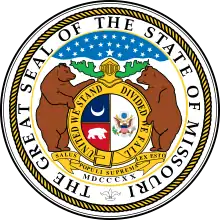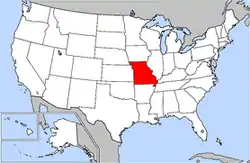Missouri bellwether
The Missouri bellwether is a political phenomenon that notes that the state of Missouri voted for the winner in all but one U.S. presidential election from 1904 to 2004 (the exception being 1956). While states like Ohio, Nevada, Florida and New Mexico have been arguably stronger indicators of political trends in recent years, Missouri was a consistent swing state throughout the 20th century. Prior to the 2008 elections, Lincoln County, Missouri was said to be the only bellwether county in a bellwether state.[1] Missouri was also considered a bellwether of U.S. views on hot-button social issues such as stem cell research[2] and school vouchers.[3] Some economists also consider the state a bellwether for economic trends such as consumer confidence and unemployment.[4]
| Elections in Missouri |
|---|
 |

Political history
From 1904 to 2004, Missouri's electoral votes went to the person who became President of the United States, with one exception: in 1956 during the landslide re-election of President Dwight Eisenhower, when Missouri went to Illinois Governor Adlai Stevenson. Missouri's accuracy in voting with the national consensus includes the "too close to call" elections of 1948 (when Missourian Harry S. Truman was elected to his only full term as president), 1960, 1976, 2000, and 2016.
In 2006, Missouri's bellwether status gained renewed attention because of the 2006 Senate race between incumbent Republican Senator Jim Talent and Democratic State Auditor Claire McCaskill, which was considered vital to which party controls Congress.[5][6] Additionally, Missouri had a ballot measure, Missouri Amendment Two, regarding stem cell research that drew national attention as an indicator of mainstream sentiment towards this controversial issue.[7] On Election Day 2006, both McCaskill and Amendment 2 narrowly received majority support among Missouri voters. The victories of McCaskill and five other Democratic colleagues allowed their party to regain power in the U.S. Senate.[8] Missouri was again the center of much media attention in 2012, after Rep. Todd Akin (R, MO-2) made controversial remarks regarding what he called "legitimate rape." Prior to these remarks, McCaskill was seen as one of the most vulnerable Democratic incumbents. McCaskill went on to win the 2012 election by nearly sixteen points.
During the 2008 presidential primaries, the state voted for the presidential candidates who eventually secured their parties' nomination: John McCain (Republican) and Barack Obama (Democratic). Missouri did the same in 2016, voting for Hillary Clinton by a razor thin margin in the Democratic primary—actually tying with her opponent Bernie Sanders in one county—and voting narrowly for Donald Trump in the Republican primary. Despite her running mate having grown-up in the state and having significant ties to the state, Clinton lost the state to Trump in the general election.
Possible causes
Location and demographics are most often cited as the cause of Missouri's bellwether status. In 2004, the Chicago Tribune called Missouri the "bellwether state that almost exactly mirrors the demographic, economic and political makeup of the nation."[9] A microcosm of the country's current political makeup, Missouri has its two Blue "coasts" of St. Louis and Kansas City with Red middle and southern areas (see Red states and blue states).
Future of bellwether status
Missouri's continuing status as a bellwether has been questioned as it has gone from a swing state to a "Red State". With the exception of two southern Governors, Jimmy Carter and Bill Clinton, they have predictably aligned with Republican candidates in elections going back to 1968. [10][11] In 2008, Missouri narrowly voted for the losing candidate, Republican John McCain, despite a sizeable electoral college win for Democrat Barack Obama. In 2012, Missouri favored losing candidate Mitt Romney by nearly 10 percentage points, despite another big victory for Barack Obama across the rest of the country. In 2016 and 2020, Missouri again voted Republican, this time for Donald Trump twice, with the second time being when it voted for the losing candidate/Republican nominee for the third time in four presidential elections.
As a result, Missouri's accuracy rate for the last 29 presidential elections is now 89.66%. Ohio has about the same record of voting for the winning candidate in missing three times; it has voted for the winner of every presidential election since 1896 except for 1944, 1960 and 2020, with no Republican ever winning the White House without Ohio. Nevada has been carried by the winner in every presidential election since 1912, except just twice in 1976 and 2016. Also, New Mexico has voted for the winner of every presidential election from its statehood in 1912 except in the 1976, 2000 and 2016 elections.
One of the more important national phenomena that has not had the same impact in Missouri as in the rest of the country is the influx of immigrants, particularly Latinos. Analysts and journalists in recent times have pointed to states like Ohio,[12] New Mexico,[13] and Pennsylvania,[14] as more accurate political and cultural bellwethers.
Also, the 21st century Missouri electorate is much less urbanized than that of the 20th century. In 1900, the combined population of St. Louis (575,238) and Kansas City (163,752) was 24% of the population of Missouri (3,106,665), while by 1950 the combined population of St. Louis (856,796) and Kansas City (456,622) had actually grown to 33% of the population of Missouri (3,954,653). But shortly thereafter the population of St. Louis began a sharp decline, while that of Kansas City remained nearly static, so that the state is now much more dominated by rural, suburban, and small-city voters, who are generally more conservative: by 2000 the combined populations of St. Louis (348,189) and Kansas City (441,545) had declined to 14% of the population of Missouri (5,595,211). This shift, however, is a direct product of the small geographic size of St. Louis City, which is nearly unique among major urban centers in having locked its boundaries in 1876. When the population of St. Louis County is included in these figures, Missouri's ratio of major metropolitan residents to rural residents closely matches the nation as a whole.
Slate columnist Chris Suellentrop has said that the state now "isn't so much a bellwether as it is a weathervane: It doesn't swing the country, the country swings it..." and that Missouri is a better indicator of whether a trend is mainstream than of what the next new trend will be.[15]
See also
References
- David Brian Robertson (2004) "Bellwether Politics in Missouri," The Forum: Vol. 2: No. 3, Article 2.
Footnotes
- Missouri Bellwether County Undecided This Election, an October 17, 2008 article from the NPR website
- Stltoday.com Churches joining stem cell showdown Archived 2006-08-21 at the Wayback Machine
- "The Heritage Foundation". Archived from the original on 2006-08-24. Retrieved 2006-08-20.
- Business Perspectives The Missouri economy: an overview
- Washington Post President Comes to Aid of Vulnerable Senator in Missouri, Seen as Bellwether State
- US News and World Report Missouri Two-step
- Pam Solo and Gail Pressberg Stem Cell Research Is Winning Mainstream Issue in 2006 Voting
- Michael Gawenda America votes for change
- Witt, Howard (November 3, 2004). "Bush leads in bellwether state". Chicago Tribune. Retrieved June 24, 2012.
- Shesgreen, Deirdre (June 24, 2012). "Missouri slips from political bellwether status this fall". USA Today. Retrieved June 24, 2012.
- Weigel, David (October 3, 2012). "Swung State". Slate. Retrieved July 19, 2015.
- Fox News Ohio Special Election Could Be '06 Bellwether
- CNN Showdown States: New Mexico
- Franklin & Marshall The Pennsylvania Paradox Archived 2006-09-03 at the Wayback Machine
- Swingers: A guide to the swing state Missouri
